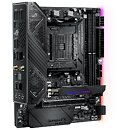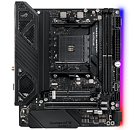Sunday, September 29th 2019

ASUS Rolls Out ROG Crosshair VIII Impact - Not Strictly Mini-ITX
ASUS over the past week rolled out its flagship socket AM4 motherboard for SFF gaming PC builds, the ROG Crosshair VIII Impact. Based on the AMD X570 chipset and supporting the latest 3rd generation Ryzen processors, this board is slightly longer than the Mini-ITX specification, while retaining its mount-hole layout. The logic here is that most ITX gaming PC cases have two expansion slots to accommodate dual-slot graphics cards, and so it would make sense to extend the motherboard's PCB up until there, reclaiming precious PCB real-estate. Technically this board would qualify as mini-DTX, but ASUS believes it should fit in most ITX cases that have two expansion slots. The board's dimensions are 203 mm x 170 mm.
The ROG Crosshair VIII Impact draws power from a combination of 24-pin ATX and 8-pin EPS connectors, conditioning power for the AM4 SoC using a massive 8-phase VRM. The AM4 socket is wired to a pair of DDR4 DIMM slots, the board's sole expansion slot, a PCI-Express 4.0 x16, and the interestingly-named SO-DIMM.2 slot. Physically, this is an SO-DIMM slot that's been re-wired with PCIe gen 4.0 leading up to a proprietary SO-DIMM daughterboard that holds two M.2-2280 slots with PCIe 4.0 x4 and SATA 6 Gbps wiring, each. Four SATA 6 Gbps ports make for the rest of the storage connectivity. The area of the motherboard just below the PCIe x16 slot has another proprietary slot that holds the second daughterboard, this one with the SupremeFX Impact IV onboard audio solution, which has been physically isolated from the main PCB, and has an EMI-shielded Realtek ALC1220 main CODEC, ESS Sabre ES9023P DAC for the main stereo channel, a de-pop circuit, and audio-grade capacitors.The chipset and VRM are cooled by an elaborate compound heatsink arrangement similar to the one on the ROG Strix X570-I Gaming, which is located near the rear I/O area, and uses a pair of fans for active cooling. The board uses a metal back-plate for additional heat dissipation. Networking options include 802.11ax Wi-Fi 6 WLAN, Bluetooth 5.0, and gigabit Ethernet, all driven by Intel-made controllers. USB connectivity includes a staggering six 10 Gbps USB 3.1 ports, one of which is type-C, and four 5 Gbps ports, two of which are located at the rear panel, four by headers. The rear I/O features the board's POST code display, and buttons for clear-CMOS, USB BIOS Flashback, and reset. There are power, POST retry, and failsafe boot buttons on the board. ASUS is pricing the ROG Crosshair VIII Impact around the USD $450-mark.
The ROG Crosshair VIII Impact draws power from a combination of 24-pin ATX and 8-pin EPS connectors, conditioning power for the AM4 SoC using a massive 8-phase VRM. The AM4 socket is wired to a pair of DDR4 DIMM slots, the board's sole expansion slot, a PCI-Express 4.0 x16, and the interestingly-named SO-DIMM.2 slot. Physically, this is an SO-DIMM slot that's been re-wired with PCIe gen 4.0 leading up to a proprietary SO-DIMM daughterboard that holds two M.2-2280 slots with PCIe 4.0 x4 and SATA 6 Gbps wiring, each. Four SATA 6 Gbps ports make for the rest of the storage connectivity. The area of the motherboard just below the PCIe x16 slot has another proprietary slot that holds the second daughterboard, this one with the SupremeFX Impact IV onboard audio solution, which has been physically isolated from the main PCB, and has an EMI-shielded Realtek ALC1220 main CODEC, ESS Sabre ES9023P DAC for the main stereo channel, a de-pop circuit, and audio-grade capacitors.The chipset and VRM are cooled by an elaborate compound heatsink arrangement similar to the one on the ROG Strix X570-I Gaming, which is located near the rear I/O area, and uses a pair of fans for active cooling. The board uses a metal back-plate for additional heat dissipation. Networking options include 802.11ax Wi-Fi 6 WLAN, Bluetooth 5.0, and gigabit Ethernet, all driven by Intel-made controllers. USB connectivity includes a staggering six 10 Gbps USB 3.1 ports, one of which is type-C, and four 5 Gbps ports, two of which are located at the rear panel, four by headers. The rear I/O features the board's POST code display, and buttons for clear-CMOS, USB BIOS Flashback, and reset. There are power, POST retry, and failsafe boot buttons on the board. ASUS is pricing the ROG Crosshair VIII Impact around the USD $450-mark.





16 Comments on ASUS Rolls Out ROG Crosshair VIII Impact - Not Strictly Mini-ITX
Looking at it it looks like their motive for their decision was to simply squeeze an m.2 on there and not make a more robust board.
DTX is like ITX + 1 PCIE slot size so it's as wide as ITX with 2 slot graphics card. It requires as much space as most ITX gaming cases have.
For most users including more demanding gamers, this board is the same as Aorus X570 I Pro WiFi but ASUS costs nearly twice as much. I mean the CPU will hit a wall at the same frequency on ambient cooling and both boards support DDR4-4800 (tested on both). For competitive benchmarking or pushing memory to the limits, ASUS will be better but not always worth the price difference.
At least with mini-DTX all the compact dual-slot GPU builds could run an extra m.2 drive or two.
I gotta say, that back plate seems excessive. It is quite fancy for something you'll never see (but it sure is nice!).
And the price, well, I just can't say how much this is just over. And where are the high-end mATX boards ASUS ?
C8I
DDR4 5000